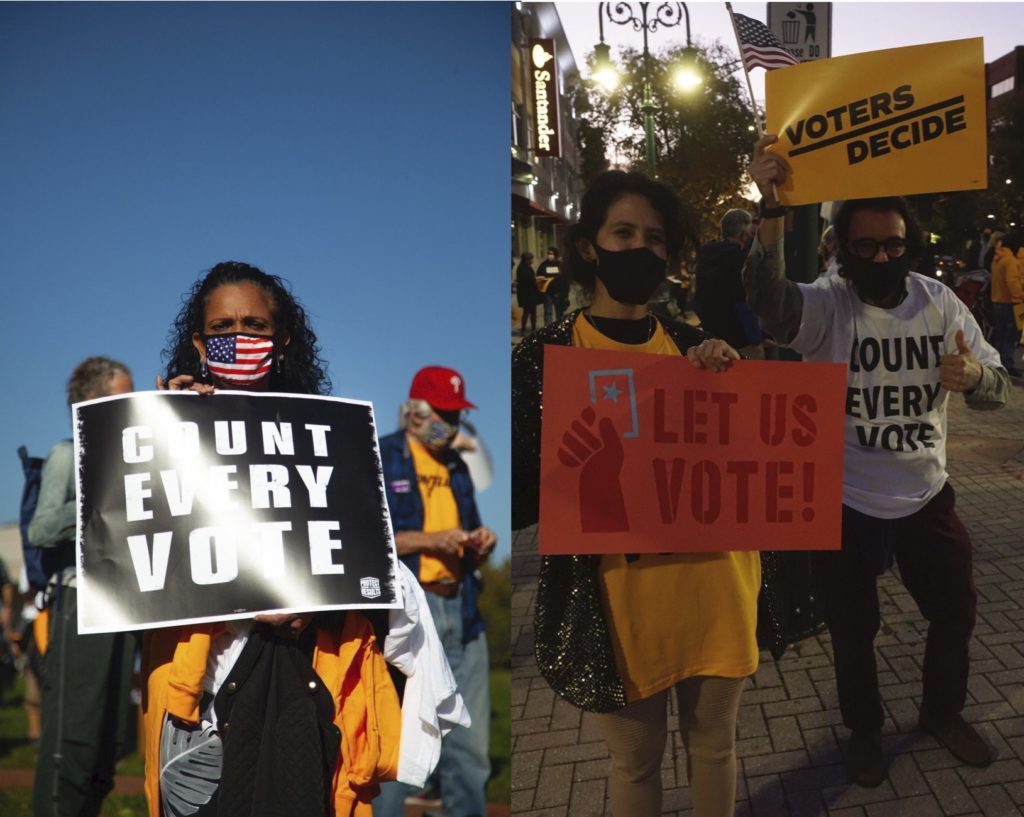Many thanks to the editors of Organizing Upgrade for coordinating responses to my essay, “The White Republic and the Struggle for Racial Justice.” And special thanks to Bill Fletcher, Jr., Gerald Horne, Erin Heaney, Peter Olney and Rand Wilson, Van Gosse, and Barry Eidlin for their thoughtful and comradely contributions to the discussion.
The respondents agreed that “white republic” is an accurate historical and strategic concept. Most used their responses to deepen, refine, and or apply it to their organizing work. They are well worth the read but too numerous for me to respond to here. However, I believe that a class realignment strategy, as outlined by Barry Eidlin, divides the antiracist forces and diverts the left from the historic racial justice struggle, so I will respond to it at the end of this note.
Fascism has a historically specific form in the U.S.
I think the terms “fascism” and “fascists” are overused and overbroad. More importantly, history itself has now produced a more specific concept that is also better understood publicly: “racist authoritarianism.” In other words, the specific form of authoritarianism and far-right populism in the U.S. is not fascism but racist authoritarianism. And the specific name of the U.S. version of fascists is white supremacists/nationalists. MAGA movement is also on point. Trumpism or Trumpists are best used when it is made clear that the main content of these terms is racist authoritarianism. It is also likely that a powerful white nationalist movement will survive Trump. Finally, some people use the term “New Confederacy,” which I am not quite ready to adopt though I see its attractions.
The structure of white minority rule
In my essay, I briefly discussed some of the critical remaining racist political institutions: the Electoral College, the Senate, gerrymandering, and various forms of voter suppression. I explored these in more depth in a previous essay, “Notes Toward a Social Justice Electoral Strategy.”
Here I want to brand this system of institutions as the “structure of white minority rule.” Without them, we would be thrashing the Trumpists. With them, we have a winnable but grueling fight ahead.
Notably, each of these institutions is part of the system of federalism enshrined in the Constitution that, among other things, purposely empowered the slaveholders at the expense of democracy.
The size of each state’s congressional delegation determines the number of votes it gets in the Electoral College. Thus, the notorious constitutional rule that counted each slave as three-fifths of a person even though they were disenfranchised enabled slaveholders to augment their representation in Congress and the Electoral College.
Today, the Electoral College still subverts the fundamental democratic principle of one person, one vote. It effectively disenfranchises about 40% of the national Black presidential vote when white Southern reactionaries outvote African Americans and thereby garner all of the electoral votes of most Southern states for the Republicans. And it gives three times as much weight to an electoral vote from small-population (primarily Republican) states as large (mostly Democratic) states. As a result, the Republicans have held the presidency for twelve years since 2020 despite losing the popular vote in all but one of those elections.
The Senate is composed of two Senators from each state, allowing the numerous small states, now overwhelmingly Trumpist, to lock in their power. Ian Millhiser, writing for Vox, calculates, “the Democratic half of the Senate represents 41,549,808 more people than the Republican half.” Thus, even if we eliminate the filibuster rule, the Senate is a bulwark of racist authoritarianism. Still, we can and must win the Senate.
Similarly, racist gerrymandering and voter suppression laws enable Trumpists to control state legislatures and congressional representation even when they lose the popular vote.
United front, popular front and democratic front
In my essay, I invoked the concept of the united front as the principal opposition to the racist authoritarians. In the 1930s and 1940s, that concept referred to building strategic unity among different working-class forces within the advanced capitalist countries. In most countries, that meant unity among social-democratic (and socialist) parties and trade unions and communist parties and unions, which together dominated the working-class movement in Europe. In the original conceptualization, the popular front was the multi-class front of all peoples’ forces against fascism, and it excluded big capitalists.
However, in my opinion, the most progressive political forces and movements in the U.S. have been multi-class for at least half a century: for example, the movements of Black people and other people of color, the multi-racial antiracist movements, the women’s movement, the movements for climate and health justice, against war, for LGBTQ rights, etc. Moreover, although working-class forces have been present in each of those multi-class groupings, they have been far weaker and less politically advanced than in Europe and the U.S. in the 1930s. At that time, they were undeniably the leading and most powerful movement.
Thus, although building the working-class movement, including working-class poles within the multi-class movements, is a crucial priority, it is likely that Black-led people of color and antiracist movements will continue to be the main anchor of the people’s movement.
Finally, I believe capitalist forces are crucial to defeating the MAGA movement, and I do not think this will change anytime soon either. By capitalist forces, I refer to most elite Democratic Party elected officials, funders, think tanks, and operatives; the mainstream media and corporate cultural institutions; large, moderate non-profit organizations and funders; liberal colleges, etc. It is significant that, so far, the only giant corporate entity publicly aligned with the Trumpists is Fox and that the mainstream media is virtually unanimous in opposition. Although the left and progressive forces have made massive gains over the last 10 years, we still have little to take the place of the crucial role those forces and institutions play.
Consequently, I purposely used the term “united front” to refer to multi-class forces united to defeat racist authoritarianism and fight for an antiracist democracy. And I believe it compels us to adopt another strategic concept that recognizes the breadth of the anti-Trumpist alliance, including capitalists: the democratic front.
Yes, including capitalists in the democratic front tremendously complicates unity and struggle dynamics within that front, with constant class struggle. But, in my opinion, that is the political reality on the ground, regardless of whether we recognize it conceptually.
Making strategic and tactical unity-and-struggle decisions regarding various capitalists is, in fact, a crucial task for virtually every social justice organization in the U.S. It is a constant in electoral, community, policy, and labor organizing and fundraising, and media work. It is almost impossible to seriously engage, let alone win any campaign, without making smart decisions about which capitalists might align with our immediate goals, which are unalterably opposed, and which might be convinced to stay neutral. This critical work is a combination of winning powerful allies and dividing our opponents.
Consequently, it is far better to consciously and strategically deal with this reality rather than allow it to blindside us or facilitate a devastating Trumpist victory by making enemies of all capitalists. We can only build the social justice movement if we can navigate the complex unity-struggle dynamics with powerful allies, even if those allies sometimes undercut, block, or even outright attack us. But, of course, this alignment of forces will almost certainly change once the white nationalists are defeated and before we win an antiracist democracy. In short, politics are in constant motion, and we need to be alert to changes that require changes in strategy and tactics. But this is my read at the moment.
Soon, I hope our movement will name itself (as the far right has) and replace the clunky concepts that we now work with. The Rainbow Coalition once accomplished this. Black Lives Matter is a significant step in that direction. Our ability to agree on a powerful identity will mark our maturation and unity and be crucial to our further development.
Class vs class is a losing strategy
I believe the strategy proposed in Barry Eidlin’s response to my essay divides the antiracist forces and diverts the left from the frontlines of the historic struggle now raging. But his and similar views are influential in the Democratic Socialists of America, which, as a national organization, still holds back from making its potentially weighty political contribution to the fight against racist authoritarianism.
Eidlin states that he agrees with me that: “Clearly any movement for social and economic justice in the U.S. must place the struggle against racism and white supremacy at its core. More specifically, it’s hard to find fault with his assessment that ‘race is the pivot of U.S. politics’ and that the contemporary Republican Party has doubled down on naked, overt racism as its fundamental appeal.” He also positively invokes the concepts of “racial capitalism” and “the white republic.”
However, the article’s strategic punchline omits all of those racial justice affirmations in favor of the class struggle between workers and capitalists: “The goal of today’s antiracist alliance should not be to array one cross-class alliance against another. Rather, it should be to realign the entire conflict along class lines.”
The lynchpin of this class strategy is a belief that racial oppression and white privilege are merely ideological, not systemic, structural, or material. Eidlin writes: “Does this mean that racist domination of Black and indigenous peoples was and is simply an instrument of economic exploitation? Far from it. Ideologies often take on a life and logic of their own once established.”
This consignment of racial oppression to “ideology” has significant consequences. Only class exploitation is considered the “material base” and, in Eidlin’s framework, is far more important than ideology. He does not consider the vast economic and social differences between whites – capitalists and non-capitalists alike – and people of color to be “a material basis of racism” since they are not, in his view, class exploitation. This analysis leads to an antiracist strategy designed to “realign the entire conflict along class lines.”
By contrast, I believe a strategy that seeks to realign antiracist struggle to class struggle rather than directly confront systemic racism and the racist state is ephemeral at best and racist class collaboration at worst (expressed, for example, in the practice of the American Federation of Labor until fairly recently).
Eidlin acknowledges that rabid exploitation of African slaves and seizure of Native land were the chief purposes of racism in the U.S. But he ignores the development of the system of white privilege that gave white supremacy its unique shape, political dynamics, and power in this country, including racist state power.
The thirteen colonies and the U.S. were the only slave societies that produced a stark racial polarization based on the one-drop rule. And the United States was the only former site of African slavery that later legally instituted and enforced, often by white terror, a systematic Jim Crow color line of white supremacy/white privilege and Black oppression throughout its economy, society, and politics. Consequently, while sharp racial disparities, discrimination, and colorism are rife in countries where Europeans enslaved Africans, racial politics are far more potent in the U.S. than in the others, and the U.S. is the only one I consider to be a white republic.
Beyond the material base
The capitalist “material base” alone cannot explain any of these unique historical developments or comprehend their specific politics. Racist exploitation and white privilege have, from the beginning, led to the creation of a vast system of economic, political, legal, and institutional structures that permeate every aspect of U.S. life. Its politics cannot be comprehended in class terms alone.
Finally, the proposed class realignment strategy downplays the power of millions of Black and Latino(a) non-working class people who possess less net wealth than white high school dropouts and whose lives do not matter to racists or the racist system. A class-versus-class strategy diminishes the grievances and political importance of the millions of non-working class whites who oppose racism. And it underestimates the crucial role of tens of millions of white workers who, as we speak, are going to the mattresses for Trumpist racist authoritarianism.
In short, this strategy weakens the antiracist forces and oversimplifies the racist forces. The left needs to take history and politics as the basis of analysis and strategy rather than squeezing reality into a theory.
Should we ever win socialism and eliminate capitalism in the U.S., significant racist stratification of the working class and society, racial profiling, and voter suppression will undoubtedly continue. So we will need to continue to systematically root it out and defeat the racist forces within the working and middle classes that promote it.


